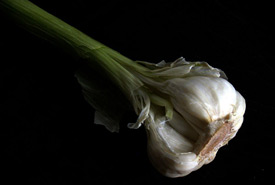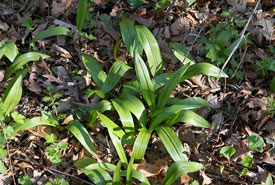Garlic: The forbidden fruit? (Part One)

Garlic (Photo by cyclonebill/Wikimedia Commons)
Picture this: the aroma of fresh garlic bread coming out of the oven to accompany your pasta dish. Garlic oil in salad dressing to top off your garden vegetables. A plant of many uses, of many medicinal properties and a kitchen staple, garlic is just great. Or at least all my family members think so. Coming from an Italian family, all my nonna's secret ingredients included garlic. And I've always liked the fact that it can ward off vampires; it just makes it that much more magical!
But did you know that Quebec has native wild garlic growing in the Eastern Townships and Outaouais regions? Did you know that over-harvesting of wild garlic has threatened the species since 1995?
Quebec is known for its wild strawberries, lavender and maple trees, but not everyone knows about the province’s native garlic, also known as wild leek or ramps, which belong to the Allium genus. So let’s strip down the peels and dig into the cloves to learn more about this cooking favourite.

Wild garlic, also known as wild leek or ramps (Photo by Wikimedia Commons)
Quebec is home to more than 20 varieties of wild garlic, which is pretty awesome considering that garlic originated in the Mediterranean climate. When the European colonists brought over garlic plants to the Americas, a good amount of garlic varieties were able to adapt and survive in temperate soils on their own.
Since local fruit and vegetables really do taste better and fresher, it’s really no surprise that garlic’s popularity in Quebec started to become a problem when supply wasn’t meeting demand.
In 1995, the Province of Quebec passed a law to control the harvesting of native wild garlic. The legal amount is 200 grams (roughly 50 bulbs) of garlic, per person, per year. However, it is to be harvested for personal consumption only and must never be taken from protected areas such as nature parks. Garlic enthusiasts are also advised to harvest only up to five per cent of any given group of garlic plants, so that the group can continue to thrive.
But as always, the moment a rule or limit is implemented, the item suddenly becomes even more popular. Alas, Quebec’s garlic became the new forbidden fruit. Rule breakers began a black market for wild garlic. All they needed to do was steal garlic bulbs and bring them over the Quebec border into Ontario, where strict laws on garlic possession don’t exist.
Thieves have been caught venturing into garlic crops at night and collecting as many garlic bulbs as their duffle bags can hold — which is waaaay over the 50-bulb limit. They also definitely don’t follow the five per cent rule, since their goal is simply to get across the border as fast as possible. If thieves make it over the border without police smelling them out, they skip out on being fined from $500 to $20,000 each (or for a company, $1,000 to $40,000!).
More than a decade later, garlic crops continue to struggle. Most people today don’t know that despite how much garlic is used in everyday life, Quebec native garlic plants are actually threatened species. Crops are not only severely affected by over-picking, but also by bad climate conditions and fungal diseases.
The minimum threshold for a wild garlic population to sustain itself is 1,000 plants. Less than that, and the crop will struggle. It’s time to wake up and smell the garlic if we want to keep our kitchen favourite!
Stay tuned for Part Two of my blog, coming out on September 29, for a 101 on the garlic plant!


